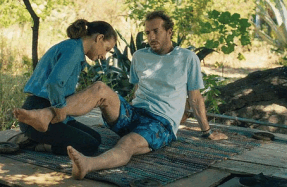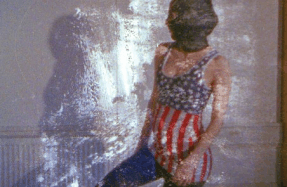
“I feel a great affinity with Poe; I understand his pain.”
—Dario Argento, interviewed by Maitland McDonagh
The first shot is a panoramic view of Rome on a bright summer day. It seems unusually quiet as we swerve along mostly depopulated streets looking through the windscreen of a car. The gliding movements produce a slightly otherworldly feel, enhanced by the floating sounds of Arnaud Rebotini’s electronic music. A shot looking up at houses, sky, and treetops warps our perception with a split-screen effect, and part of the image shows views from an alternate angle, as if two images coming from different directions had aligned themselves magically on the same pane of glass. Counter-shots show the person whose point of view we are sharing: a female driver (Ilenia Pastorelli) looking out, and looking at other people looking.
Everybody is staring into the sky, wearing special glasses or holding up black strips to protect their eyes. She stops at a park, joining a small group of people, putting on her sunglasses. Dogs bark as the light dims—they are awaiting a solar eclipse. “Not just dogs, every animal is afraid,” a man explains to his kid. “Even our ancestors, a long time ago, feared the eclipse.” His wife adds, “They thought the disappearance of the sun meant the end of the world.” As the world is momentarily plunged into darkness, the woman reaches for her eyes. Soon, we will learn her ancient Roman (and pagan) name, Diana, whose meaning is both “heavenly” and “demonic,” translating more broadly as “which has the light,” but also “which belongs to the void.” Finally, the opening shot reappears, but the city is now completely engulfed by black shade, announcing the endless night awaiting the protagonist. The drive of Rebotini’s music picks up, its register now reminiscent of John Carpenter’s classic minimalist scores, and the credits come in.
The effectively eerie five-minute opening of heralds Dario Argento’s return to movie-directing after a ten-year hiatus—partly for health reasons, partly because projects fell through. Elegantly shot and privileging atmosphere over content, this portentous intro is a restrained reminder of the qualities that have made the octogenarian Argento one of the most influential genre directors alive, despite the fact that after his breakthrough success in the ’70s his films have curried little favour with critics upon their initial release. Already in the ’80s, Argento films now considered classics were mostly dismissed, and since the ’90s even the faithful horror fanbase has reacted with increasing skepticism, although Argento’s filmography is arguably all of one piece, for better or worse. Thus his comeback, premiered as a Berlinale Special Gala, would seem reason to rejoice, but current culture has little respect for small gifts of this kind, regardless of their relative merits. Like Carpenter’s (2010) and Brian De Palma’s (2019), heralds the unexpected resurfacing of a master’s touch in a minor key, and under problematic conditions—yet some day, these late works may come to be rediscovered as last hurrahs for a certain kind of auteurist cinephilia, contemporary equivalents to something like Fritz Lang’s (1960).






